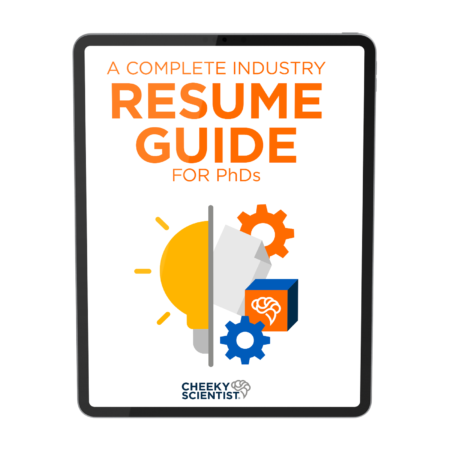How Women PhDs Can Use LinkedIn When Searching For A STEM Job

As I neared the end of my PhD, the stress that I felt about the future increased exponentially.
I did not want to stay in academia and pursue a postdoc, but I felt like I was not qualified to do anything except stay in the university setting.
In fact, I hardly felt qualified to do a postdoc.
The level of self-doubt that I was experiencing was so high, that I was certain someone would find out that I was a fraud and not let me graduate.
I was suffering from extreme Imposter Syndrome.
Later, I found out that many women in STEM face similar feelings of self-doubt.
But, when I was in the middle of experiencing Imposter Syndrome, I felt like I was the only one who lacked confidence — I felt isolated.
Thankfully, I found an amazing mentor who encouraged me to join a few women in science networking groups.
This was a turning point for me.
I met women PhDs, both in person and online, who were happily working in industry.
They talked with me about their experiences with self-doubt and how they overcame them.
They showed me the many opportunities that were available to me in industry as a STEM PhD .
It was an eye-opening experience, and helped me secure my first industry position.
Why It’s Important For Women In STEM To Network On LinkedIn

Women are underrepresented in STEM careers.
According to the National Science Foundation, only 14.5% of engineers are women, only 26.4% of math and computer science positions are filled by women, and only 27.8% of professionals working in the physical sciences are women.
As a woman with a PhD who is looking to get hired in the STEM fields, you are a minority.
And, this makes networking very important.
Because, as a PhD, you are qualified for more than just an entry position in industry.
You have the technical and transferable skills required to secure a management position in industry.
But, women are also underrepresented in management positions.
As reported by INC., no matter what the field, women represent only 37% of management-level positions.
And, this disparity becomes even greater as you move up the management hierarchy.
According to Fortune, only 4.8% of Fortune 500 companies have a woman CEO.
As a woman with a STEM PhD, you have the ability to change this number.
You are capable of securing a management-level industry position, that can lead to a C-level position.
But, you will need to network.
You will need the support from your fellow women in STEM, as well as the support of other STEM leaders, both men and women, who are willing to help you in your career progression.
And, the LinkedIn networking platform provides a great place to expand your network and connect with industry professionals.
3 Ways Women STEM PhDs Can Use LinkedIn Networking To Get Hired
Networking and earning a referral increase your chances of getting hired.
But, networking will also allow you to find an organization whose company culture aligns with your values.
This is especially important because, as a woman in STEM, you are a minority.
It’s important to find a company that will encourage your career development and support you through the unique obstacles that you face as a woman in STEM.
Here are 3 ways women in STEM can leverage LinkedIn in their job search to get hired in industry…
1. Join an online women-in-STEM organization.

There are many types of women-in-STEM LinkedIn groups.
These groups are designed to support women who are pursuing STEM careers.
You can use these groups as a place to connect with other women who are in the careers that you are interested in.
The women in these groups are great candidates for setting up informational interviews because they already have a passion for supporting women in STEM.
This means that they will be more likely to want to chat with you and help you however they can.
Use these informational interviews to learn about the positions you are interested in, as well as to learn what different career paths look like.
To further leverage these groups, it’s a great idea to volunteer for them.
Many times, these organizations will have local meetups or online meetups that require organizing, and you can volunteer to help.
Volunteering is a great way to get involved with a group if you are nervous about reaching out to a cold contact, or sharing directly into the group.
When searching for groups to join, look for both large scale groups and smaller local groups.
Just a few of the larger organizations for women in STEM include: Women in Bio, Association for Women in Science, Society for Women Engineers, and Girl Geeks. And, there are many, many more groups like these.
Do a bit of research and find the networking groups that are right for you.
But remember, don’t just use these groups to get what you need — find a way to give back.
As a woman with a PhD, you can become a mentor for other women and girls in STEM.
Don’t let Imposter Syndrome keep you from using your experiences and expertise to lift up other women in STEM.
2. Use the online forum to remain connected during career breaks.
Many women face the unique challenge of having a career break when they have children.
This can be a tough time for many women PhDs.
As reported by the Society For Human Resource Management, 56% of women in the STEM fields quit their careers after 10-15 years.
And, many women report that they left their STEM career because they felt isolated.
Online networking is a way to stay connected to your STEM community, even when you are not in the workforce.
In addition to joining LinkedIn groups, you should develop a plan to regularly publish on the LinkedIn Pulse.
As a PhD, you have the expertise to add to the professional discourse on LinkedIn.
And, you can make valuable contributions to your network by writing and publishing short articles on LinkedIn.
These can be short summaries of a recent paper or news article you’ve read, or they can even be about your experiences as a woman in STEM, or as a working mother.
Sharing with your online community will allow you to stay more connected to your industry during a career break, and when you do want to re-enter the workforce, you will already have a network ready to help you.
It is possible to get hired in industry even if you have had an extensive break from the workforce.
And, using your LinkedIn network to stay connected during a career break will make re-entering industry a smoother process.
3. Set up informational interviews with industry professionals in management-level positions.

One of the easiest ways to network with industry professionals is to set up informational interviews.
An informational interview can be done in person, over the phone, over Skype, or even via messaging.
The main goal of an informational interview is to begin to build a relationship with someone at a company, or in a position that you are interested in.
You can set up conversations with people in a variety of positions at a variety of companies, but make sure that you include some people who work in management-level positions.
The representation of women in high-level management positions is low.
So, even if you are just beginning your transition from academia to industry, it’s important that you seek out connections with people in management positions.
Having connections in management-level positions will help you envision what your career path could look like beyond the first industry position you get.
Since many women leave their careers before they have the chance to move into management positions, understanding that you can move up the management hierarchy from the moment you enter industry is essential.
Plus, if the informational interviews that you have with management-level industry employees lead to referrals, your chances of getting hired will skyrocket.
As reported by US News, a staggering 91% of candidates referred by a director-level employee were hired, compared with 53% for those candidates who were referred by an entry-level employee.
Networking with people who have higher level management positions will help you in both the short-term, by increasing your chances of getting hired, and in the long-run, by showing you the path that you can take to move into these higher level positions yourself.
Making the transition from academia to industry as a woman in STEM can be intimidating. Many women suffer from Imposter Syndrome and face the reality that the majority of STEM positions are filled by men. But, networking online is a great way to overcome those feelings of self-doubt and connect with industry professionals who can help you in your transition. You can use LinkedIn to join online women in STEM organizations, to stay connected with your field during career breaks, and to set up informational interviews with industry professionals in management-level positions. LinkedIn is the largest online networking platform for professionals and is a resource that can dramatically increase the success of your industry job search as a woman in STEM.
If you’re ready to start your transition into industry, you can apply to book a free Transition Call with our founder Isaiah Hankel, PhD or one of our Transition Specialists. Apply to book a Transition Call here.

ABOUT CATHERINE SORBARA, PH.D.
Cathy has a PhD in Medical Life Science and Technology and is COO of the Cheeky Scientist Association. Cathy is passionate about science communication including translating science to lay audiences and helping PhDs transition into industry positions. She is Chair of Cambridge AWiSE, a regional network for women in science, engineering and technology. She has also been selected to take part in Homeward Bound 2018, an all-female voyage to Antarctica aimed to heighten the influence of women in leadership positions and bring awareness to climate change.
More Written by Catherine Sorbara, Ph.D.































